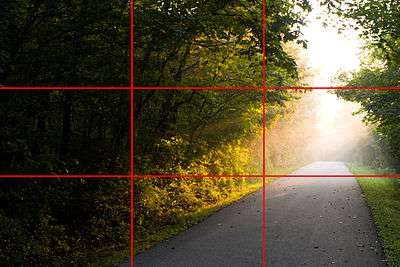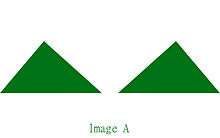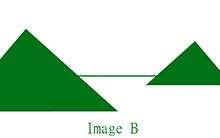Composition (visual arts)

In the visual arts, composition is the placement or arrangement of visual elements or ingredients in a work of art, as distinct from the subject. It can also be thought of as the organization of the elements of art according to the principles of art.
The term composition means 'putting together' and can apply to any work of art, from music to writing to photography, that is arranged using conscious thought. In the visual arts, composition is often used interchangeably with various terms such as design, form, visual ordering, or formal structure, depending on the context. In graphic design for press and desktop publishing, composition is commonly referred to as page layout.
Elements of design
The various visual elements, known as elements of design, formal elements, or elements of art, are the vocabulary with which the visual artist composes. These elements in the overall design usually relate to each other and to the whole art work.
The elements of design are:
- Line — the visual path that enables the eye to move within the piece
- Shape — areas defined by edges within the piece, whether geometric or organic
- Colour — hues with their various values and intensities
- Texture — surface qualities which translate into tactile illusions
- Tone — Shading used to emphasize form
- Form — 3-D length, width, or depth
- Space — the space taken up by (positive) or in between (negative) objects
- Depth — perceived distance from the observer, separated in foreground, background, and optionally middle ground
Line and shape
Lines are optical phenomena that allow the artist to direct the eye of the viewer. The optical illusion of lines do not exist in nature, but in visual arts elements can be arranged to create this illusion. The viewer unconsciously reads near continuous arrangement of different elements and subjects at varying distances. Such elements can be of dramatic use in the composition of the image. These could be literal lines such as telephone and power cables or rigging on boats. Lines can derive also from the borders of areas of differing color or contrast, or sequences of discrete elements. Movement is also a source of line, and blur can also create a reaction.
Subject lines contribute to both mood and linear perspective, giving the viewer the illusion of depth. Oblique lines convey a sense of movement and angular lines generally convey a sense of dynamism and possibly tension. Lines can also direct attention towards the main subject of picture, or contribute to organization by dividing it into compartments. The artist may exaggerate or create lines perhaps as part of their message to the viewer. Many lines without a clear subject point suggest chaos in the image and may conflict with the mood the artist is trying to evoke.
Straight left lines create different moods and add affection to visual arts. A line's angle and its relationship to the size of the frame influence the mood of the image. Horizontal lines, commonly found in landscape photography, can give the impression of calm, tranquility, and space. An image filled with strong vertical lines tends to have the impression of height and grandeur. Tightly angled convergent lines give a dynamic, lively, and active effect to the image. Strongly angled, almost diagonal lines produce tension in the image. The viewpoint of visual art is very important because every different perspective views different angled lines. This change of perspective elicits a different response to the image. By changing the perspective only by some degrees or some centimetres lines in images can change tremendously and a totally different feeling can be transported. Straight lines are also strongly influenced by tone, color, and repetition in relation to the rest of the image.
Compared to straight lines, curves provide a greater dynamic influence in a picture. They are also generally more aesthetically pleasing, as the viewer associates them with softness. In photography, curved lines can give graduated shadows when paired with soft-directional lighting, which usually results in a very harmonious line structure within the image.
Colour
Color is characterized by attributes such as hue, brightness, and saturation. Color symbolism assigns additional associations, dependent on culture. For example, white has long suggested purity, but it can also take slightly different meanings such as peace, or innocence. However, in some places (for instance, Japan and China) it signifies death.
Principles of organization
The artist determines what the center of interest (focus in photography) of the art work will be, and composes the elements accordingly. The gaze of the viewer will then tend to linger over these points of interest, elements are arranged with consideration of several factors (known variously as the principles of organization, principles of art, or principles of design) into a harmonious whole which works together to produce the desired statement – a phenomenon commonly referred to as unity. Such factors in composition should not be confused with the elements of art (or elements of design) themselves. For example, shape is an element; the usage of shape is characterized by various principles.
Some principles of organization affecting the composition of a picture are:
- Shape and proportion
- Positioning/orientation/balance/harmony among the elements
- The area within the field of view used for the picture ("cropping")
- The path or direction followed by the viewer's eye when they observe the image.
- Negative space
- Color
- Contrast: the value, or degree of lightness and darkness, used within the picture.
- Arrangement: for example, use of the golden mean or the rule of thirds
- Lines
- Rhythm
- Illumination or lighting
- Repetition (sometimes building into pattern; rhythm also comes into play, as does geometry)
- Perspective
- Breaking the rules can create tension or unease, yet it can add interest to the picture if used carefully
Viewpoint (leading the eye)
The position of the viewer can strongly influence the aesthetics of an image, even if the subject is entirely imaginary and viewed "within the mind's eye". Not only does it influence the elements within the picture, but it also influences the viewer's interpretation of the subject.
For example, if a boy is photographed from above, perhaps from the eye level of an adult, he is diminished in stature. A photograph taken at the child's level would treat him as an equal, and one taken from below could result in an impression of dominance. Therefore, the photographer is choosing the viewer's positioning.
A subject can be rendered more dramatic when it fills the frame. There exists a tendency to perceive things as larger than they actually are, and filling the frame full fills this psychological mechanism. This can be used to eliminate distractions from the background.
In photography, altering the position of the camera can change the image so that the subject has fewer or more distractions with which to compete. This may be achieved by getting closer, moving laterally, tilting, panning, or moving the camera vertically.
Compositional techniques
There are numerous approaches or "compositional techniques" to achieve a sense of unity within an artwork, depending on the goals of the artist. For example, a work of art is said to be aesthetically pleasing to the eye if the elements within the work are arranged in a balanced compositional way.[1] However, there are artists such as Salvador Dalí who aim to disrupt traditional composition and challenge the viewer to rethink balance and design elements within art works.
Conventional composition can be achieved with a number of techniques:
Rule of thirds
The rule of thirds is a composition guide that states that arranging the important features of an image on or near the horizontal and vertical lines that would divide the image into thirds horizontally and vertically is visually pleasing. The objective is to stop the subject(s) and areas of interest (such as the horizon) from bisecting the image, by placing them near one of the lines that would divide the image into three equal columns and rows, ideally near the intersection of those lines.

The rule of thirds is thought to be a simplification of the golden ratio. The golden ratio is thought to have been used by artists throughout history as a composition guide, but there is little evidence to support this claim.
Rule of odds
The "rule of odds" states that by framing the object of interest with an even number of surrounding objects, it becomes more comforting to the eye, thus creates a feeling of ease and pleasure. It is based on the assumption that humans tend to find visual images that reflect their own preferences/wishes in life more pleasing and attractive.
The "rule of odds" suggests that an odd number of subjects in an image is more interesting than an even number. Thus if you have more than one subject in your picture, the suggestion is to choose an arrangement with at least three subjects. An even number of subjects produces symmetries in the image, which can appear less natural for a naturalistic, informal composition.
An image of a person surrounded/framed by two other persons, for instance, where the person in the center is the object of interest in that image/artwork, is more likely to be perceived as friendly and comforting by the viewer, than an image of a single person with no significant surroundings.
Rule of space
The rule of space applies to artwork (photography, advertising, illustration) picturing object(s) to which the artist wants to apply the illusion of movement, or which is supposed to create a contextual bubble in the viewer's mind.
This can be achieved, for instance, by leaving white space in the direction the eyes of a portrayed person are looking, or, when picturing a runner, adding white space in front of him rather than behind him to indicate movement.
Simplification
Images with clutter can distract from the main elements within the picture and make it difficult to identify the subject. By decreasing the extraneous content, the viewer is more likely to focus on the primary objects. Clutter can also be reduced through the use of lighting, as the brighter areas of the image tend to draw the eye, as do lines, squares and colour. In painting, the artist may use less detailed and defined brushwork towards the edges of the picture.Removing the elements to the focus of the object, taking only the needed components.
Shallow Depth of Field
In photography, and also (via software simulation of real lens limitations) in 3D graphics, one approach to achieving simplification is to use a wide aperture when shooting to limit the depth of field. When used properly in the right setting, this technique can place everything that is not the subject of the photograph out of focus.
 The blurred background focuses the eye on the flowers. |
 At a smaller aperture, the background competes for the viewer’s attention. |
A similar approach, given the right equipment, is to take advantage of the Scheimpflug principle to change the plane of focus.
Geometry and symmetry
Related to the rule of odds is the observation that triangles are an aesthetically pleasing implied shape within an image. In a canonically attractive face, the mouth and eyes fall within the corners of the area of an equilateral triangle. Paul Cézanne successfully used triangles in his compositions of still lifes. A triangular format creates a sense of stability and strength.
Creating movement
It is generally thought to be more pleasing to the viewer if the image encourages the eye to move around the image, rather than immediately fixating on a single place or no place in particular. Artists will often strive to avoid creating compositions that feel "static" or "flat" by incorporating movement into the image. In image A the 2 mountains are equally sized and positioned beside each other creating a very static and uninteresting image. In image B the mountains are differently sized and one is placed closer to the horizon, guiding the eye to move from one mountain to the other creating a more interesting and pleasing image. This also feels more natural because in nature objects are rarely the same size and evenly spaced.


Other techniques
- There should be a center of interest or focus in the work, to prevent it becoming a pattern in itself;
- The direction followed by the viewer's eye should lead the viewer's gaze around all elements in the work before leading out of the picture;
- The subject should not be facing out of the image;
- Exact bisections of the picture space should be avoided;
- Small, high contrast, elements have as much impact as larger, duller elements;
- The prominent subject should be off-centre, unless a symmetrical or formal composition is desired, and can be balanced by smaller satellite elements
- the horizon line should not divide the art work in two equal parts but be positioned to emphasize either the sky or ground; showing more sky if painting is of clouds, sun rise/set, and more ground if a landscape
These principles can be means of a good composition yet they cannot be applied separately but should act together to form a good composition.
- Also, in your work no spaces between the objects should be the same. They should vary in shape and size. That creates a much more interesting image.
Example
These paintings all show the same subject, the Raising of Lazarus, and essentially the same figures, but have very different compositions:
-

Duccio, 1310–11
-

Geertgen tot Sint Jans, 1480s
-

Guercino, c. 1619
-

Rembrandt, c. 1630
See also
- Miksang (contemplative photography)
- New Epoch Notation Painting (a notation system for painting)
- Page layout (graphic design)
- CLACL (a computer language for composition)
References
- ↑ Dunstan, Bernard. (1979). Composing Your Paintings. London, Studio Vista.
Further reading
- Arnheim, Rudolf (1974). Art and Visual Perception: A Psychology of the Creative Eye. University of California Press. ISBN 978-0-520-02613-1.
- Downer, Marion (1947). Discovering Design. Lothrop Lee & Shepard. ISBN 0-688-41266-1.
- Graham, Peter (2004). An Introduction to Painting Still Life. Chartwell Books Inc. ISBN 0-7858-1750-6.
- Grill, Tom; Scanlon, Mark (1990). Photographic Composition. Watson-Guptill Publications. ISBN 0-8174-5427-6.
- Peterson, Bryan (1988). Learning to See Creatively. Watson-Guptill Publications. ISBN 0-8174-4177-8.
- Langford, Michael (1982). The Master Guide to Photography. New York: Dorling Kindersley Limited. ISBN 0-394-50873-4.
External links
| Wikimedia Commons has media related to Composition. |
- Percy Principles of Art and Composition, Goshen College Art Department